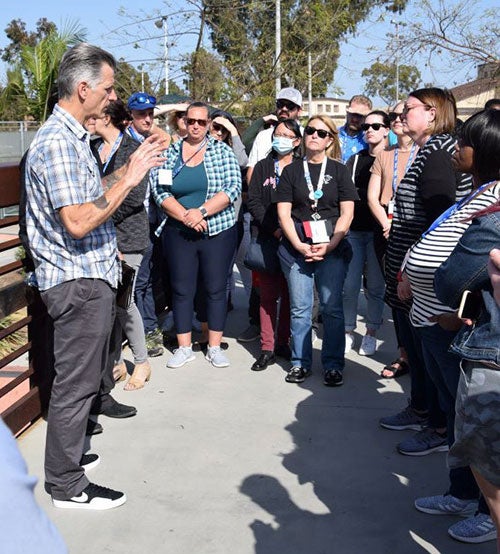Inclusive Engagement Techniques and Approaches
Tours and Field Trips

What is it?
Tours and field trips involve visiting a location to get a first-hand experience of a project site. Subject matter experts or guides typically lead tours and field trips to provide context and facilitate learning and input. These activities can increase awareness about a topic or explore sites and surrounding communities for future projects.
When to use it
Tours and field trips can be effective immediately following project kick-off to familiarize stakeholders with a particular location or site. They can also be used to gather input and understand perceptions and challenges about buildings and infrastructure. Tours and field trips can also show project progress or display a project with very similar characteristics to the one proposed.
How to do it
Before
- Identify a tour/field trip location based on objectives. Gather information about the location’s hours of operation, tour options, educational programs, security and any special permission requirements or restrictions.
- If feasible, perform a site visit prior to the tour/field trip to assess any conditions that may warrant additional accommodations or safety measures.
- Determine the tour/field trip date, time, guide(s) and invited participants.
- Invite participants using a registration link to collect contact information and cap the number of participants as needed.
- Choose a time when the location is active. For example, if the tour is to learn more about the location's physical characteristics there may be times that are better suited to see those in action.
- Consider preparing a microphone and speaker or other form of voice amplification for the tour guide to ensure participants can hear.
- Consider arranging transportation to and from the destination.
- Consider factors such as distance, travel time, parking and accessibility. If using buses or other transportation services, make reservations well in advance.
- Identify staff able to participate and support the tour/field trip. Ensure City staff subject matter experts are available to address questions the public may have.
- Create and share a detailed itinerary that outlines the logistics of the tour/field trip at least two weeks in advance.
- Include information such as departure and arrival times, transportation and/or parking information, scheduled activities, maps, meal arrangements and safety procedures.
- Distribute and collect liability waiver and photo release forms signed by tour/field trip participants.
- This can be done electronically via email prior to the tour/field trip and/or in person via printed copies prior to boarding City-arranged transportation or at the beginning of the tour.
- Check weather conditions in advance of the tour/field trip.
- Remind staff to dress accordingly.
- If temperatures of 80°F or higher are anticipated, ensure water and shade are available and/or consider postponing the tour/field trip.
During
- If collecting input is part of the objective, supply participants with clipboards, pens and comment forms for recording observations.
- The tour/field trip leader should wear City-branded clothing or be otherwise easily identifiable.
After
- Collect input from participants’ comment forms and digitize as needed to inform project decisions.
- Note any future opportunities for engagement and/or share how input will impact decision-making.
- Consider distributing participant satisfaction surveys to learn how participants felt the tour/field trip went and make improvements for the future.
Resource considerations
![]()
Cost: Minimal to Moderate
Costs depend on any fees assessed at the location, for the tour guide, participation support and transportation.
![]()
Time: Moderate
Planning and setting up the tour/field trip can take a month or longer. The tour/field trip itself may last an hour or more.
![]()
Capacity: Minimal
Tours/field trips typically require at least two staff members to plan and execute.
How to make it more inclusive
- Consider any language access needs in advance and consider providing participation support.
- Choose a location that is fully accessible, including parking, entrances and restrooms. Choose venues that are near transit and that have adequate parking.
- Choose venues that are near transit and that have adequate parking.
- Check weather conditions in advance of the tour/field trip, if it will occur outdoors.
- Remind team members to dress accordingly.
- If temperatures at 80°F or higher are anticipated, ensure water and shade are available and/or consider postponing the tour/field trip.
- Consider the time when planning a tour/field trip.
- If participants are attending as part of their jobs, workday hours are preferred. If participants are attending on their own time, consider conducting it in the evening or on a weekend.
Inclusive Engagement Techniques and Approaches
- Introduction
- Appreciative Inquiry
- Arts-based Engagement
- Briefings
- Comment Forms
- Community Cafés
- Community Mapping
- Community Office Hours
- Email Notifications
- Engagement through Service
- Fact Sheets
- Flyers
- Focus Groups
- Game-based Approaches
- Hotlines
- Information Kiosks
- Interviews
- Meeting in a Box
- Mobile Engagement
- News Releases
- Newsletters
- Open Houses
- Participation Support
- Pop-Up Events
- Project Models
- Project-specific Groups
- Public Meetings
- Public Service Announcements (PSAs)
- Social Media
- Surveys and Polls
- Tours and Field Trips
- TV/Radio/Podcast Interviews
- Vision Walls
- Web-Based/Hybrid Meetings
- Webpages
- Workshops


 Inclusive Public Engagement Guide
Inclusive Public Engagement Guide